Graffiti is a powerful form of artistic expression that transforms urban landscapes into vibrant canvases for social commentary. It reflects community sentiments, highlights social issues, and challenges societal norms. Notable artists like Banksy and Jean-Michel Basquiat influence urban photography trends with their culturally rich works. Photographers face challenges such as lighting conditions and legal restrictions while capturing this dynamic art form.
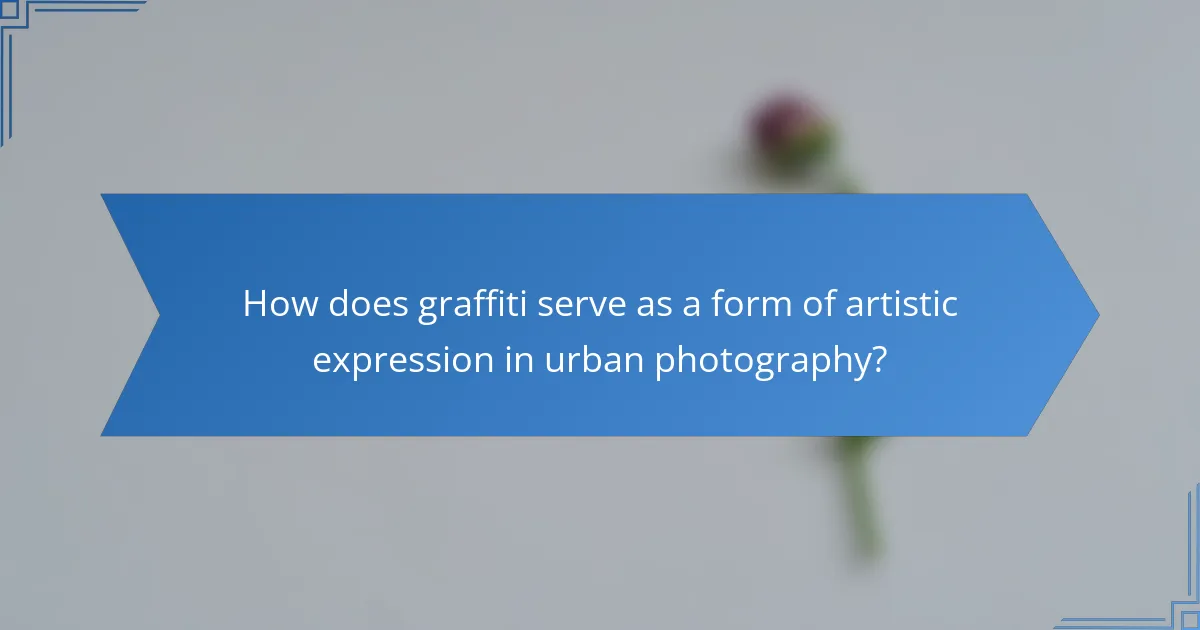
How does graffiti serve as a form of artistic expression in urban photography?
Graffiti serves as a powerful form of artistic expression in urban photography by transforming public spaces into canvases for social commentary. It conveys messages about identity, culture, and politics, often reflecting the community’s sentiments. The vibrant colours and unique styles of graffiti enhance urban landscapes, making them visually engaging. Moreover, graffiti artists use their work to challenge societal norms, provoking thought and dialogue among viewers. This dynamic interplay between graffiti and urban photography captures the essence of contemporary life, showcasing art’s role in shaping urban narratives.
What are the key techniques used in photographing graffiti?
Key techniques in photographing graffiti include using natural light for vibrancy, selecting angles that emphasize scale, and incorporating urban context for storytelling. Additionally, employing close-up shots captures intricate details, while wide shots showcase the artwork in its environment. Experimenting with different focal lengths can highlight unique attributes of the graffiti, enhancing the artistic expression. Lastly, post-editing techniques can enhance colours and contrast, bringing the cultural commentary to life.
Which elements contribute to the aesthetic appeal of graffiti in urban settings?
The aesthetic appeal of graffiti in urban settings is shaped by vibrant colours, intricate designs, cultural relevance, and social messages. These elements create visual interest and provoke thought among viewers.
Graffiti often incorporates unique styles, such as tagging or mural art, which reflect individual artist identities. The context of the urban environment enhances its impact, making public spaces canvases for artistic expression. As a result, graffiti becomes a dialogue between the artist and the community, enriching the cultural landscape.
Additionally, the ephemeral nature of graffiti adds to its allure, as pieces may be temporary and subject to change. This dynamic quality invites ongoing engagement and appreciation from the public.
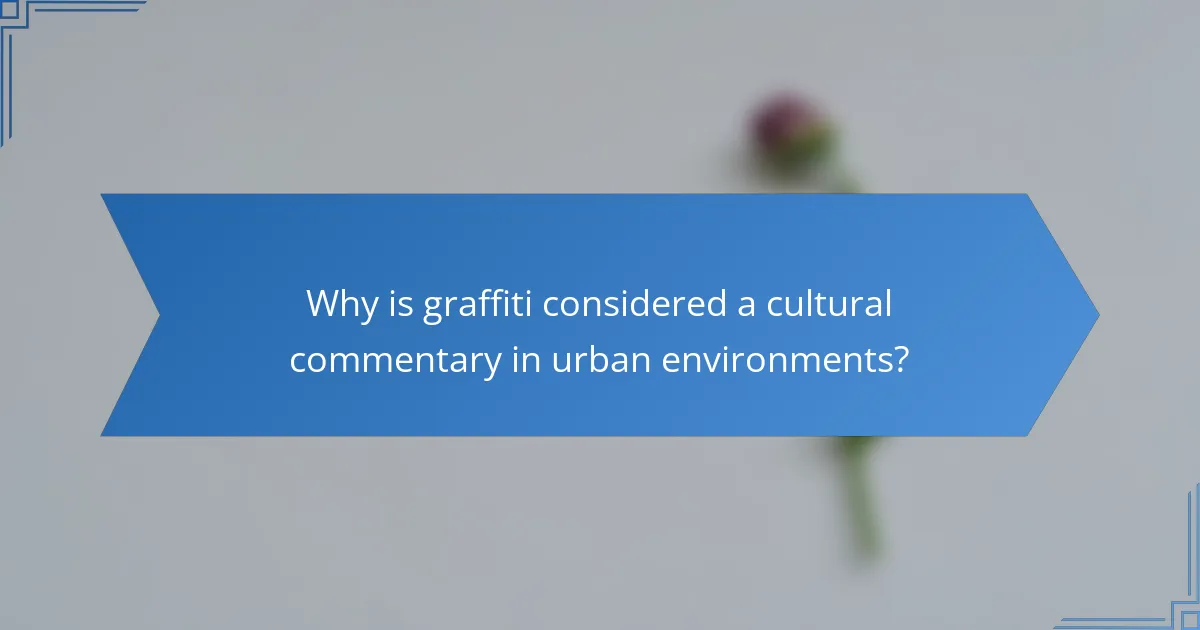
Why is graffiti considered a cultural commentary in urban environments?
Graffiti serves as a powerful cultural commentary in urban environments by reflecting social issues and community sentiments. It often highlights themes like inequality, identity, and resistance, making it a visual dialogue between artists and the public. By utilizing public spaces, graffiti artists challenge societal norms and provoke thought, offering insights into the local culture and its struggles. This form of artistic expression transcends traditional boundaries, creating a unique blend of art and activism that resonates with diverse audiences.
How do social and political messages manifest in graffiti art?
Social and political messages manifest in graffiti art through visual symbolism and provocative imagery. Artists use graffiti to express dissent, raise awareness, and engage communities in dialogue. Common themes include social justice, anti-establishment sentiments, and political critique. The unique attribute of graffiti is its accessibility; it reaches diverse audiences in urban spaces. As a result, graffiti serves as a powerful medium for cultural commentary and social change.
What role does graffiti play in community identity and activism?
Graffiti plays a significant role in shaping community identity and activism by serving as a powerful medium for self-expression and social commentary. It reflects local culture, history, and collective sentiments, allowing artists to voice concerns and provoke thought. For example, murals can celebrate cultural heritage or highlight social issues, fostering a sense of belonging among residents. Furthermore, graffiti often acts as a catalyst for activism, mobilising communities around causes such as racial equality, environmental justice, and political change. This unique aspect of graffiti positions it as both an artistic form and a tool for community engagement.
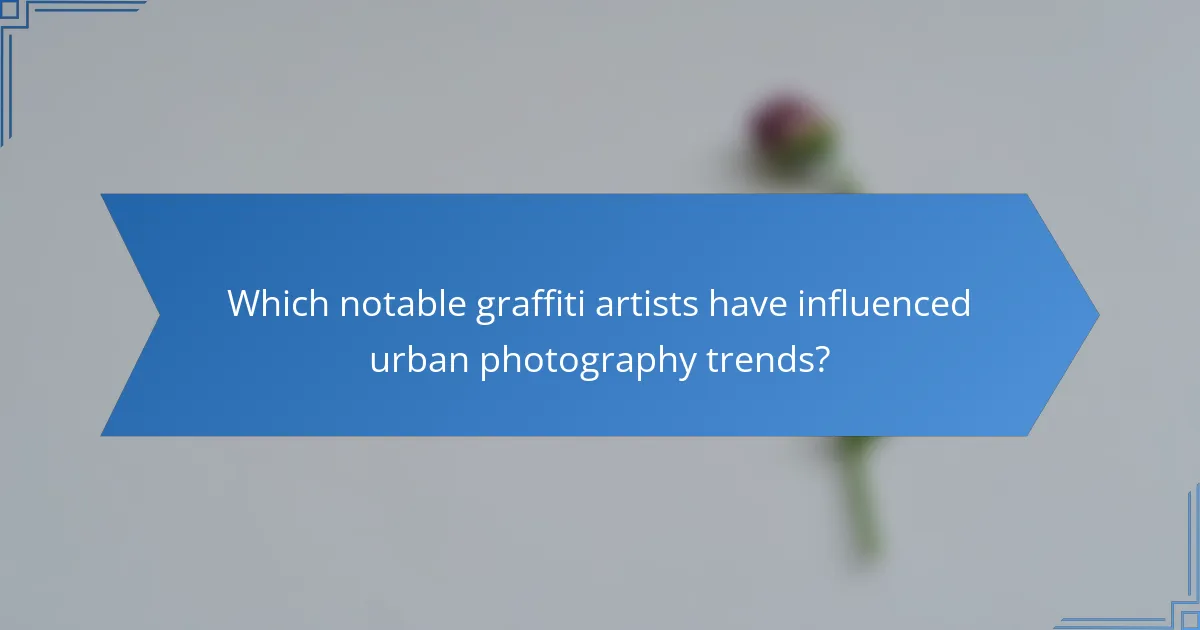
Which notable graffiti artists have influenced urban photography trends?
Notable graffiti artists like Banksy, Jean-Michel Basquiat, and Keith Haring have significantly influenced urban photography trends. Their work often incorporates social commentary, prompting photographers to capture the intersection of art and urban life. Banksy’s politically charged pieces encourage photographers to explore themes of resistance and identity. Basquiat’s vibrant style and cultural critiques inspire a focus on the raw energy of urban environments. Haring’s iconic imagery promotes the integration of art into everyday spaces, impacting how photographers frame their subjects in urban settings.
What are the unique styles and signatures of famous graffiti artists?
Famous graffiti artists exhibit unique styles and signatures that reflect their individual creativity. For example, Banksy is known for satirical and politically charged stencils, while Jean-Michel Basquiat incorporated abstract forms and social commentary. Shepard Fairey’s work often features bold colours and propaganda-style imagery. Each artist’s signature style serves as a cultural commentary, enhancing urban photography’s narrative depth.
How do regional differences shape the work of graffiti artists?
Regional differences significantly influence graffiti artists by shaping their themes, styles, and techniques. Local culture, history, and social issues directly inform the messages conveyed in their work. For instance, urban environments with rich cultural narratives often inspire artists to reflect local struggles and triumphs. In contrast, areas with stricter regulations may lead to more clandestine and provocative expressions.
Additionally, the availability of materials and public spaces can vary widely, affecting how artists create and exhibit their work. In cities with supportive art communities, graffiti can flourish as a legitimate form of expression, while in others, it may be viewed purely as vandalism.
The unique attributes of each region, such as its socio-political climate and community values, further differentiate the artistic approaches taken by graffiti artists. This diversity enriches the global graffiti landscape, making it a vibrant form of cultural commentary.
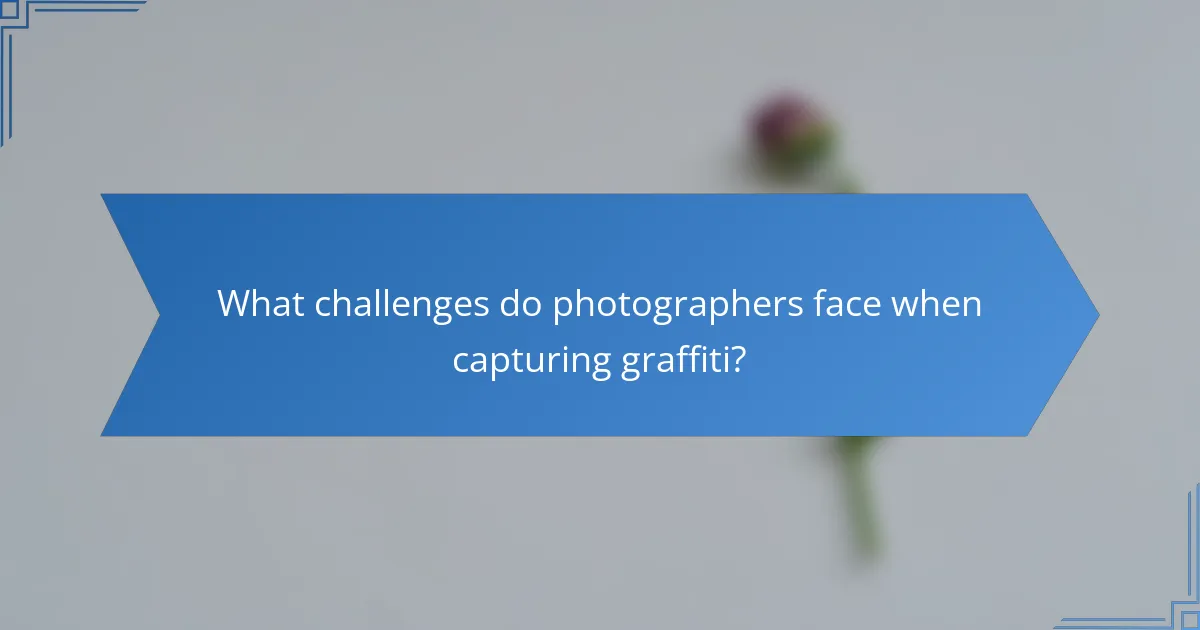
What challenges do photographers face when capturing graffiti?
Photographers face several challenges when capturing graffiti, including lighting conditions, legal restrictions, and the dynamic nature of urban environments.
Lighting can be unpredictable, affecting the visibility and vibrancy of colours in graffiti. Photographers often work in low-light situations or harsh sunlight, which complicates exposure settings.
Legal restrictions present another hurdle. Many graffiti artists create their work illegally, leading to potential encounters with law enforcement. This adds stress and urgency to the photography process.
Finally, the dynamic nature of urban environments means graffiti can be ephemeral. Pieces may be painted over or removed quickly, requiring photographers to act swiftly to capture their subjects.
How does the legality of graffiti impact urban photography?
The legality of graffiti significantly affects urban photography by shaping the environment and context in which artists operate. Legal graffiti spaces often encourage creativity, leading to vibrant urban photography opportunities. Conversely, illegal graffiti can create tension, influencing photographers to capture the contrast between art and law. This dynamic interplay enriches the narrative within urban photography, highlighting social issues and cultural commentary. For example, areas with legal murals may attract tourists, while hidden, unauthorised pieces may tell stories of rebellion and resistance.
What ethical considerations arise when photographing graffiti?
Photographing graffiti raises ethical considerations regarding consent, ownership, and cultural representation. Photographers must navigate the balance between artistic expression and respect for the rights of graffiti artists. Unauthorized photography can lead to misrepresentation of the artist’s intent and cultural context. Additionally, the commercialization of graffiti images without artist consent can exploit the original creators. Understanding these dynamics is crucial for ethical urban photography.
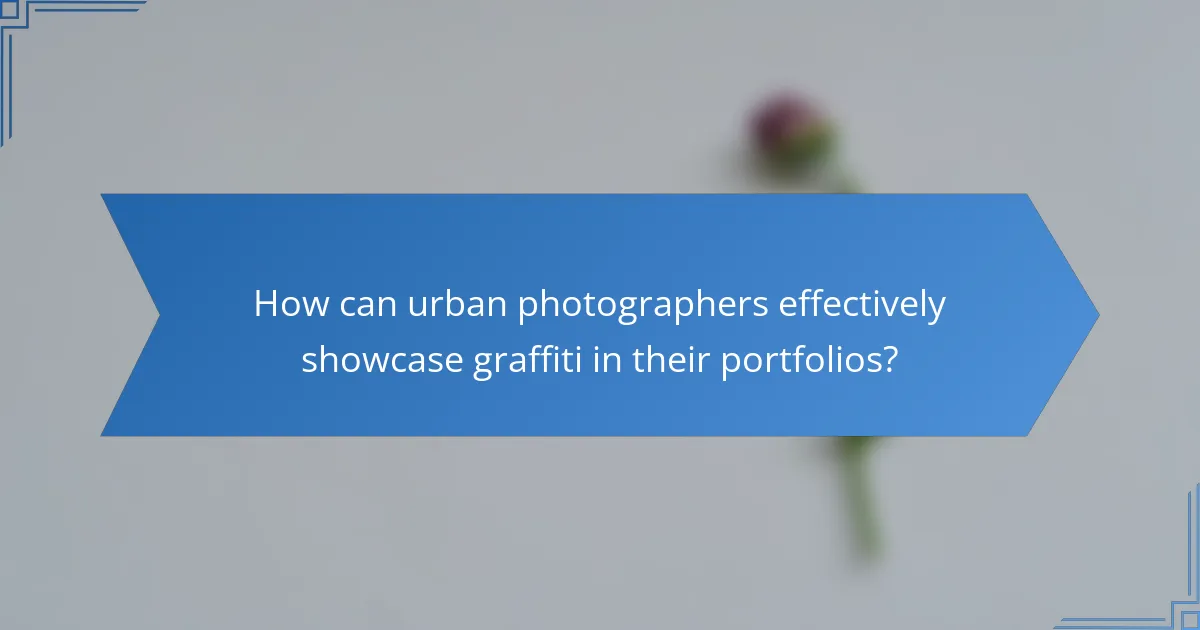
How can urban photographers effectively showcase graffiti in their portfolios?
Urban photographers can effectively showcase graffiti by capturing its vibrant colours, intricate details, and contextual surroundings. Focus on lighting, angles, and composition to highlight the artwork’s message and cultural significance. Engage with the local community to understand the stories behind the pieces, adding depth to your portfolio. Experiment with different formats, such as close-ups or wide shots, to create a dynamic visual narrative.
What are the best practices for lighting and composition in graffiti photography?
To achieve impactful graffiti photography, prioritise natural lighting and dynamic composition. Use soft, diffused light during golden hour for enhanced colours. Frame your shots to include context, highlighting the relationship between the graffiti and its surroundings. Experiment with angles to create depth and interest. Incorporate leading lines to guide the viewer’s eye toward the artwork.
Which platforms are most effective for sharing graffiti photography?
Social media platforms are most effective for sharing graffiti photography. Instagram, Facebook, and Pinterest provide visual-centric environments that engage audiences.
Instagram thrives on visual storytelling, allowing artists to showcase their work through images and hashtags. Facebook offers community groups where photographers can connect and share insights. Pinterest serves as a visual discovery tool, enabling users to curate boards of graffiti art, attracting followers interested in urban aesthetics.
Each platform facilitates interaction and feedback, enhancing the visibility of graffiti photography within artistic and cultural contexts.
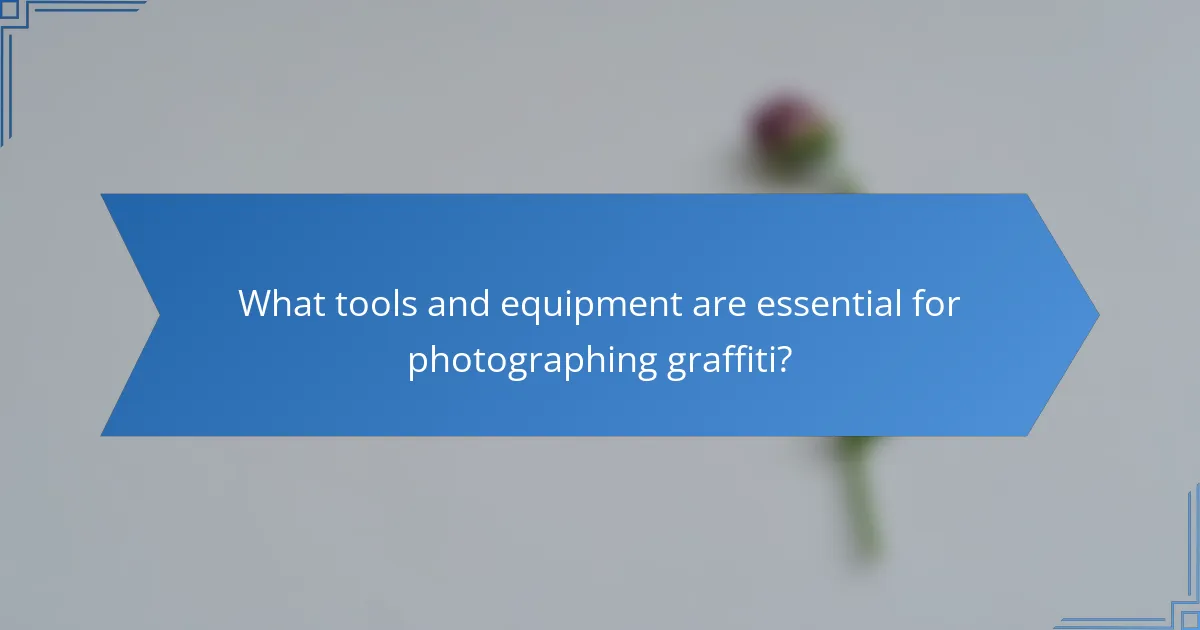
What tools and equipment are essential for photographing graffiti?
To photograph graffiti effectively, essential tools include a camera, tripod, and editing software. A DSLR or mirrorless camera offers high-quality images, while a tripod ensures stability for long exposures. Editing software enhances colours and details, showcasing graffiti’s vibrancy. Additional accessories like lenses and filters can expand creative options.
How does camera choice affect the quality of graffiti images?
Camera choice significantly impacts the quality of graffiti images by influencing clarity, colour accuracy, and composition. High-resolution cameras capture intricate details and vibrant colours, enhancing the artwork’s visual appeal. Lenses with wide apertures can create striking depth of field, isolating graffiti from the background. Additionally, the choice between digital and film cameras affects the texture and mood of the images. For example, digital cameras often provide better low-light performance, essential for urban environments. Ultimately, selecting the right camera can elevate graffiti photography from mere documentation to a compelling artistic expression.
Which editing techniques enhance graffiti photographs?
Effective editing techniques for graffiti photographs include enhancing colours, adjusting contrast, and cropping for composition. These methods highlight the vibrancy and details of the artwork, improving visual impact. Utilizing sharpness adjustments can also accentuate textures, making the graffiti more striking. Additionally, applying filters can create a mood that complements the cultural context of the piece.
What common mistakes should photographers avoid when capturing graffiti?
Photographers should avoid several common mistakes when capturing graffiti to ensure their work reflects the art’s essence.
First, neglecting the context of the graffiti can lead to missed opportunities for storytelling. Graffiti often interacts with its surroundings, contributing to urban narratives. Second, poor lighting can diminish the vibrancy and details of the artwork. Natural light usually enhances colours, while harsh shadows can obscure key elements.
Third, failing to consider composition can result in cluttered images. A well-framed shot highlights the graffiti and its environment. Lastly, not obtaining permission can lead to legal issues. Respecting the artist’s work fosters positive relationships within the community.